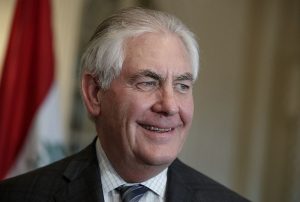North Korea Threat Looms Over Secretary of State Tillerson’s Asia Trip
The Stream - Wednesday March 15, 2017
by MATTHEW PENNINGTON

TOKYO (AP) -- On his first trip to Asia as top U.S. diplomat, Rex Tillerson wants to forge cooperation with Japan, South Korea and China against the nuclear threat from North Korea and demonstrate “America First” does not mean a U.S. diplomatic retreat from the volatile region.
Tillerson will find shared anxiety at the North’s saber-rattling but less agreement about how to deal with it, and unresolved questions about how the United States and China, the world’s two largest economies, can manage growing differences.
Japan and South Korea, which host American troops and are already within range of North Korean missiles, support U.S. efforts to increase diplomatic and economic pressure on Pyongyang. The three navies were also conducting missile defense information-sharing drills Wednesday in seas east of the divided Korean Peninsula and north of Japan to promote interoperability, the U.S. Navy’s 7th Fleet said.
But China remains conflicted about how to treat its traditional ally for fear of triggering its collapse.
Adding to the combustible mix of military tension and the region’s historic rivalries is another factor -- uncertainty about U.S. foreign policy under the Trump administration.
Tillerson, who arrives in Tokyo late Wednesday at the start of his four-day, three-nation tour, could provide some reassurance to nervy allies. He will meet Thursday with Japanese Prime Minister Shinzo Abe and Foreign Minister Fumio Kishida.
The former Exxon Mobil CEO has adopted a low profile during his six weeks as secretary of state. The State Department Correspondents’ Association expressed disappointment Wednesday that Tillerson was traveling to Asia without a full contingent of the diplomatic press corps or even a pool reporter on his plane -- although it is taking a reporter from the conservative-leaning website, the Independent Journal Review.
President Donald Trump’s rise to power has raised anxiety in Asian capitals. During last year’s election campaign, Trump asked whether allies like Japan and South Korea contribute enough for their own defense or should get their own nuclear weapons. He also questioned the fundamentals of four decades of U.S. diplomacy with China.
Trump has allayed some of those concerns since taking office. Trump hosted Abe at his Florida resort last month, and when Tillerson goes to Beijing Saturday, he is expected to arrange a much-anticipated visit by Chinese President Xi Jinping to the U.S.
“The U.S. allies, Japan and South Korea, want to know that the United States is going to continue to defend them but also is going to show a certain amount of finesse and diplomatic skills in dealing with China and with North Korea,” said Robert Dujarric, the director of the Institute of Contemporary Asian Studies at Temple University’s campus in Tokyo.
North Korea will be a top priority on all Tillerson’s stops. The State Department says Tillerson wants to discuss “fresh” approaches. Administration officials say all options are on the table, including military ones, but signs are that the U.S. for starters wants to see rigorous implementation of existing sanctions against Pyongyang.
There appears to be little desire for now to negotiate with North Korea, unless it commits to denuclearization, which it shows no sign of doing.
The North conducted two nuclear tests and 24 ballistic missile tests last year, deepening concern in Washington that it could soon develop a nuclear-tipped missile capable of reaching the U.S. mainland -- something Trump has vowed won’t happen.
The U.S. is currently involved in annual military drills in South Korea that North Korea regards as rehearsal for invasion. In a show of defiance, the North fired four ballistic missiles into ocean off Japan last week. The next day, the U.S. began bringing in equipment for the long-planned deployment in South Korea of a missile defense system, known by its acronym, THAAD.
That has raised tensions with China, which says the THAAD’s radar could peer into Chinese territory, weakening its own nuclear deterrent. The U.S. says the system is intended to be used only against North Korea.
After Tokyo, Tillerson visits South Korea, caught up in political upheaval after last week’s ouster of its president, Park Geun-hye, over a corruption scandal. Park had been in lockstep with Washington’s efforts to isolate Pyongyang. The favorite to succeed her is Moon Jae-in, a moderate who wants to engage North Korea’s government.
Tillerson’s final leg involves meetings with several senior Chinese officials in Beijing. China recently announced it was suspending for the rest of the year coal imports that are an important source of revenue for North Korea. That is to comply with U.N. sanctions aimed at restricting the North’s nuclear and ballistic missile programs.
Chinese Premier Li Keqiang on Wednesday called for all parties to return to talks. Aid-for-disarmament negotiations have been stalled for years. Last week China’s foreign minister warned the U.S., South Korea and North Korea could be heading for conflict.
____
Associated Press writer Ken Moritsugu contributed to this report.
Copyright 2017 The Associated Press. All rights reserved. This material may not be published, broadcast, rewritten or redistributed.
Read More Here
No comments:
Post a Comment